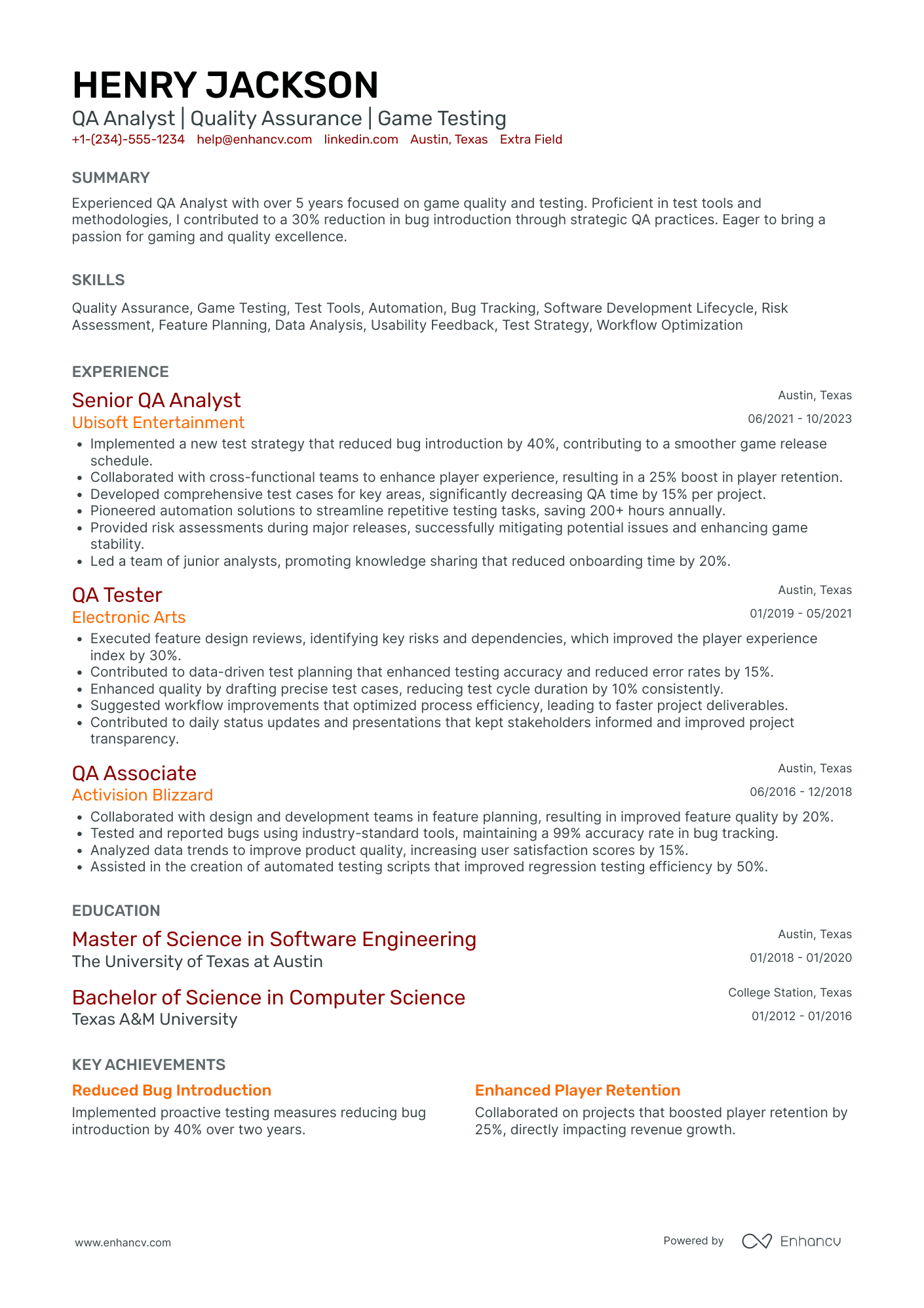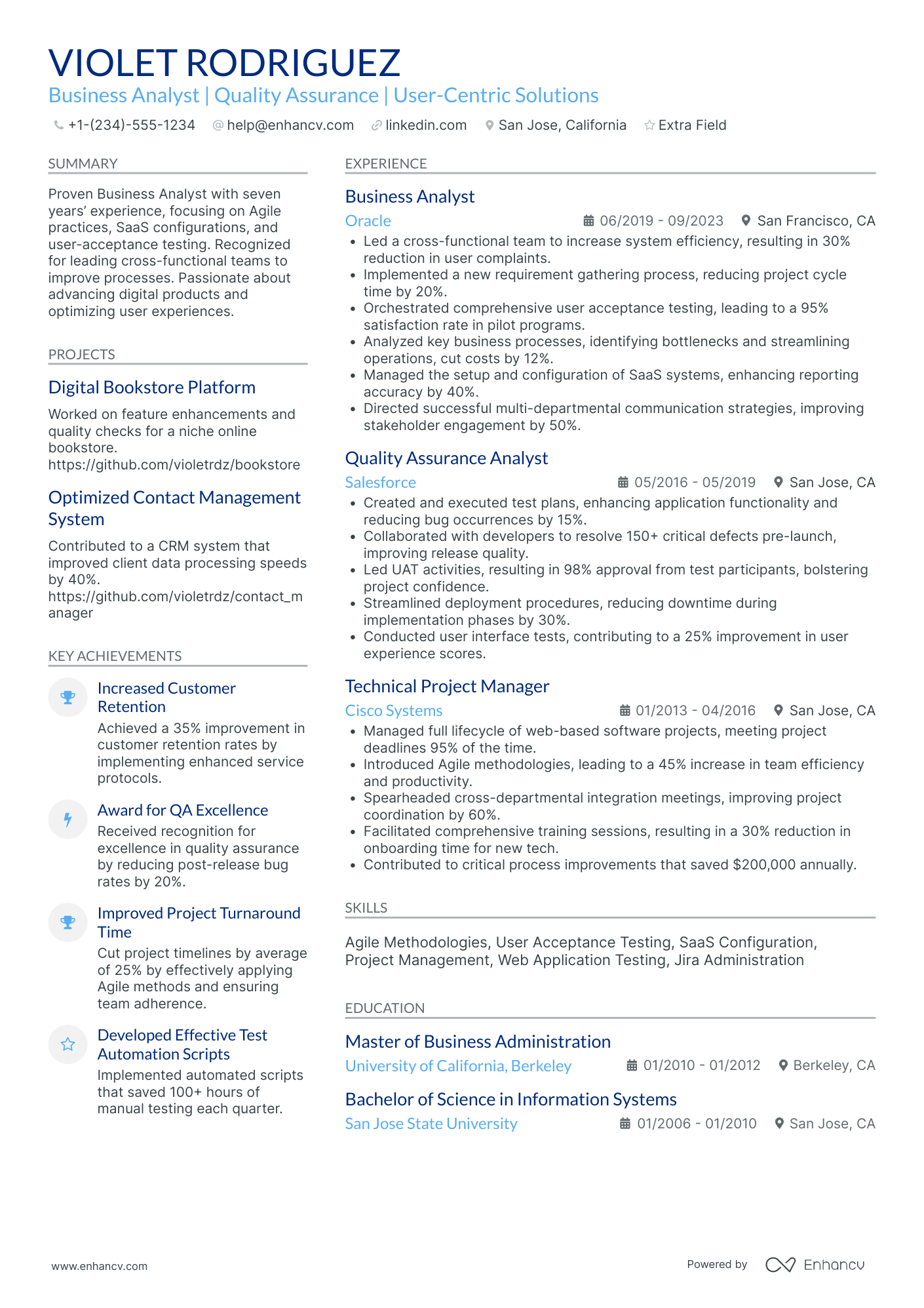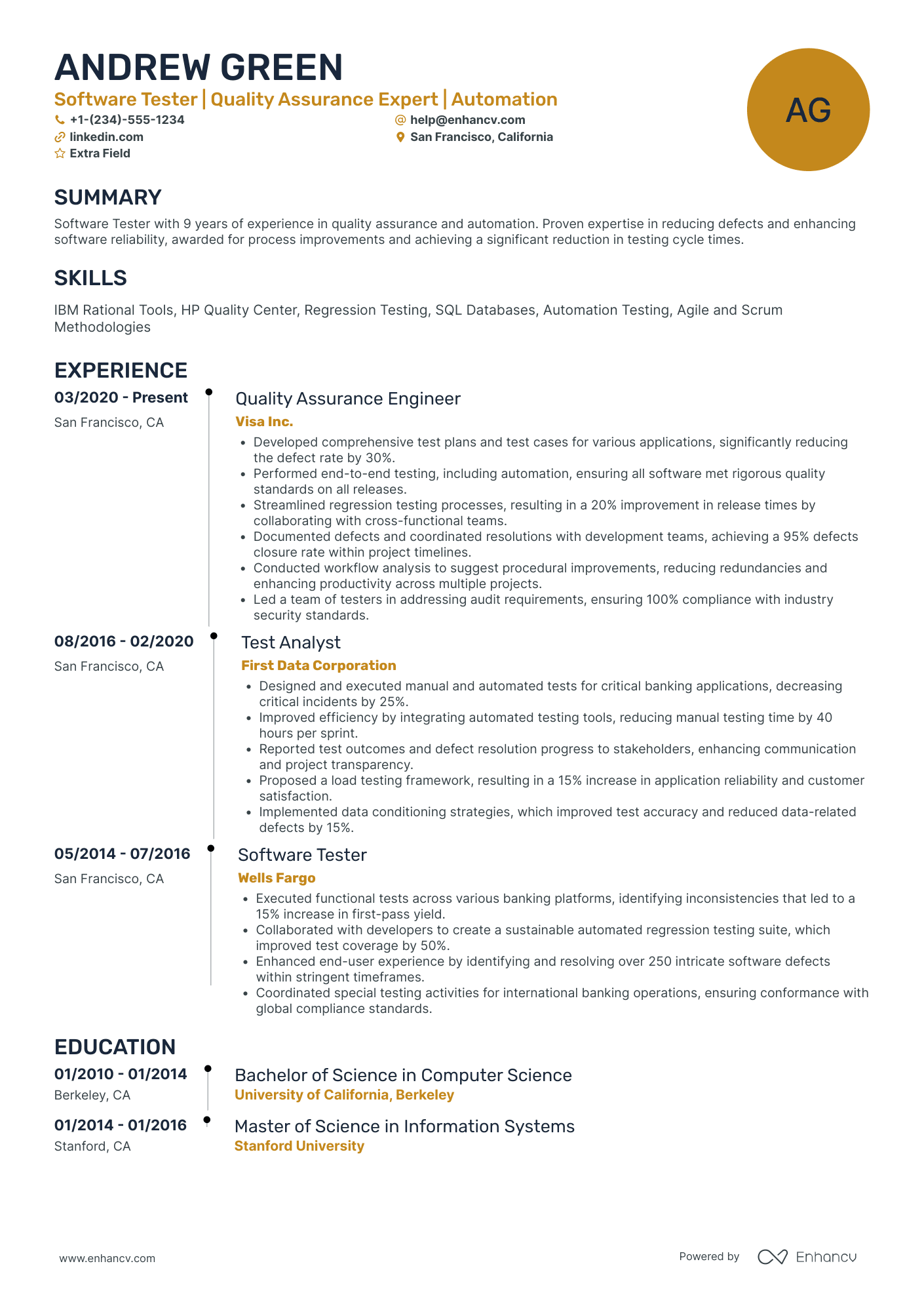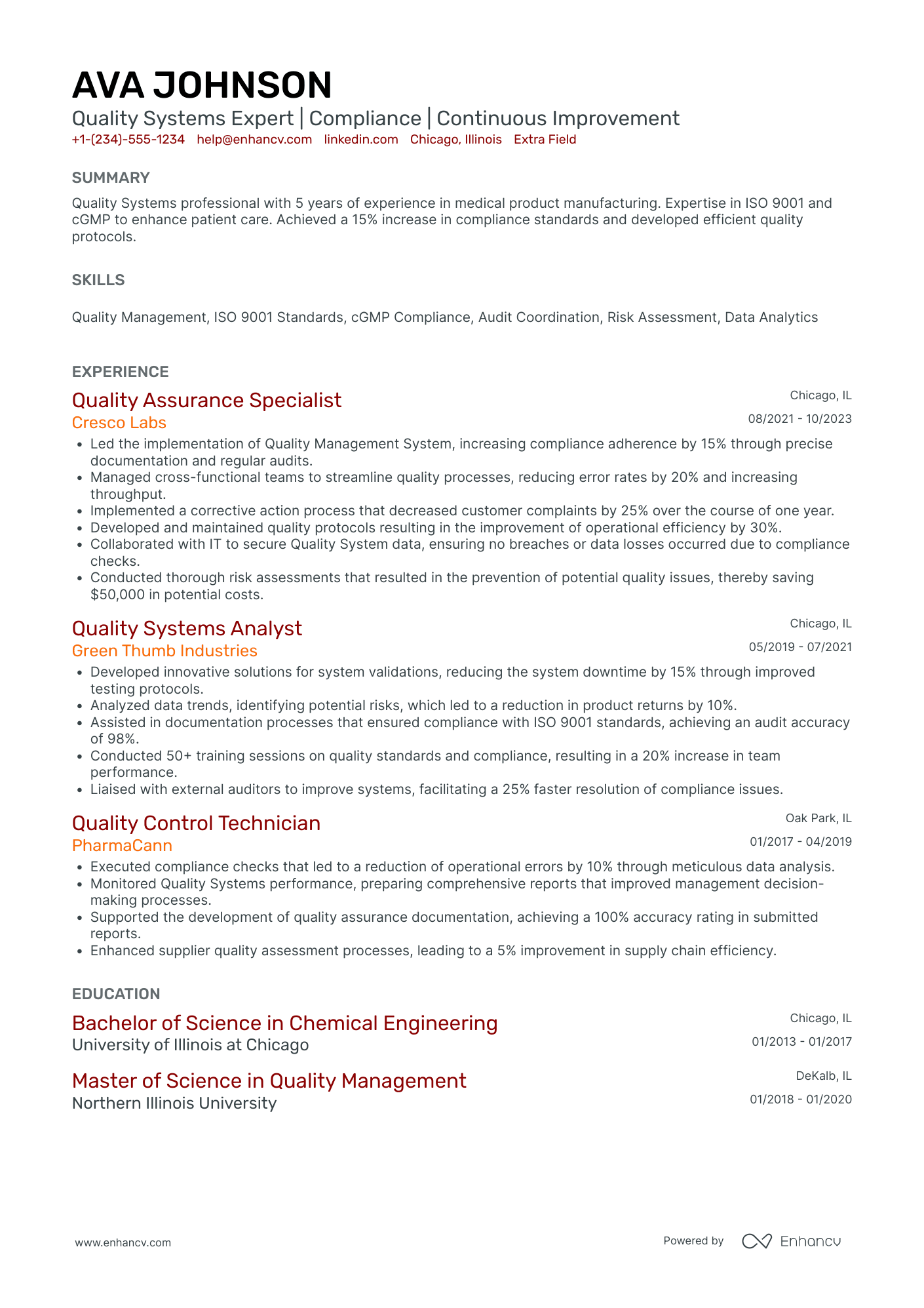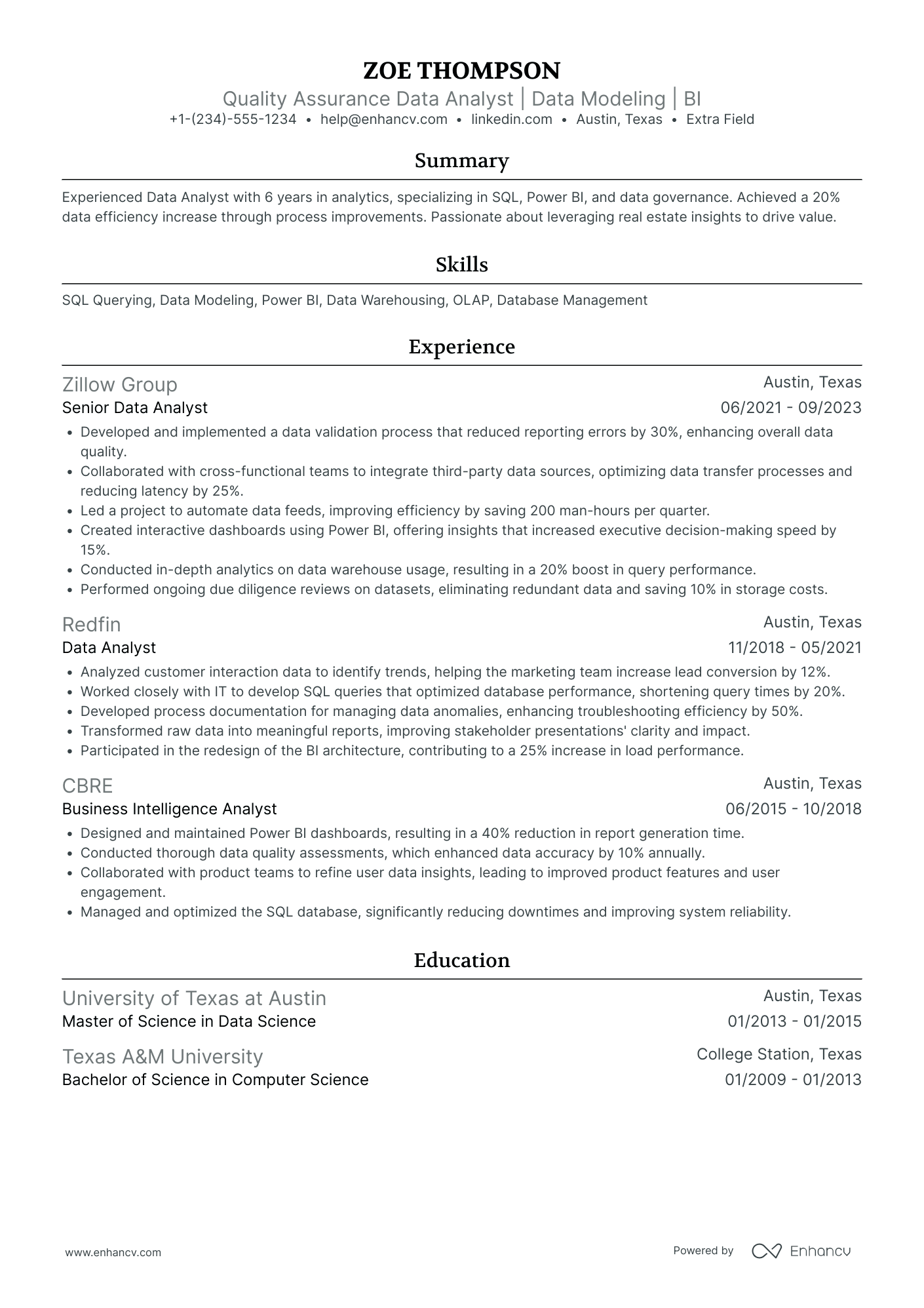As a QA analyst, you may struggle with effectively conveying your diverse testing skills and experience with various QA tools and methodologies within the concise confines of a resume. Our guide provides you with tailored tips and techniques to showcase your proficiencies and accomplishments, ensuring you capture the attention of potential employers with a polished and professional summary of your QA qualifications.
- Apply best practices from professional resumes to spotlight your application;
- Quantify your professional experience with achievements, career highlights, projects, and more;
- Write an eye-catching QA analyst resume top one-third with your header, summary/objective, and skills section;
- Fill in the gaps of your experience with extracurricular, education, and more vital resume sections.
We've selected, especially for you, some of our most relevant QA analyst resume guides. Getting you from thinking about your next career move to landing your dream job.
The Importance of Format and Layout in Your QA Analyst Resume
Consider you're an HR professional at company X, evaluating two QA analyst candidate resumes. John Smith presents a simple, traditional, and easy-to-read resume. Edward Price, however, uses a non-conventional, often illegible format. Whose resume would you spend more time on to understand their experience? This scenario underscores the importance of your QA analyst resume’s design. It should be simply formatted and clearly communicate why you are the ideal candidate for the role.
Achieve this balance by:
- Listing your experience, beginning with the most recent and relevant, in reverse chronological order;
- Ensuring your header contains essential information, such as contact details, a headline, and a portfolio link. Include a professional photo in the QA analyst resume header if you have one;
- Including only the most important and relevant resume sections to showcase your expertise and stand out from other candidates;
- Editing your QA analyst resume to be no longer than two pages if you have extensive relevant experience. Use your limited resume space judiciously.
Also, remember that your QA analyst resume might initially be scanned by an Applicant Tracker System (ATS).
When it comes to ATS:
- Opt for simple and legible fonts like Raleway, Rubik, Lato, etc., making your experience easy for the ATS to scan;
- Use serif and sans-serif fonts, both of which are ATS-friendly;
- Avoid overused options like Arial and Times New Roman, which, while suitable, may lack personality.
Contrary to a common myth, our recent study shows that the ATS can effectively process both one-column and two-column resumes. Learn more about this in the ATS myths guide.
Finally, when submitting your QA analyst resume, always export it as a PDF to ensure all information remains intact, making the document easier to print, read, and scan.
Align your resume with the market’s standards – Canadian resumes may have unique layout guidelines.
Upload & Check Your Resume
Drop your resume here or choose a file. PDF & DOCX only. Max 2MB file size.
PRO TIP
List all your relevant higher education degrees within your resume in reverse chronological order (starting with the latest). There are cases when your PhD in a particular field could help you stand apart from other candidates.
Ensure your QA analyst resume stands out with these mandatory sections:
- Header - the section recruiters look to find your contact details, portfolio, and potentially, your current role
- Summary or objective - where your achievements could meet your career goals
- Experience - showcasing you have the technical (and personal) know-how for the role
- Skills - further highlighting capabilities that matter most to the QA analyst advert and your application
- Certifications/Education - staying up-to-date with industry trends
What recruiters want to see on your resume:
- Experience with various testing techniques and methodologies (e.g., manual testing, automated testing, regression testing, performance testing).
- Proficiency in test case development, test plan creation, and defect tracking.
- Familiarity with Quality Assurance software tools and platforms (e.g., JIRA, Selenium, TestRail, Postman).
- Knowledge of Software Development Life Cycle (SDLC) and Agile methodologies.
- Strong analytical skills and attention to detail to identify bugs and ensure the quality of the product.
Experts' Advice on Writing Your QA Analyst Resume Experience
While the excitement and motivation for writing your QA analyst resume was present in the first hour (or so), you now find yourself staring at the blank page.
The resume experience section is the one that allows you to make a memorable impression by matching job requirement with your past jobs and accomplishments.
To help you write this resume section, here are four mistakes you need to avoid:
- Listing every job you have had so far, including the irrelevant ones. Before that, consider each of your past roles based on relevancy to the role. It may be the case that the job you had 15 years ago may have taught you invaluable skills that are appropriate for the role;
- Including irrelevant work experience items. Those are past jobs that aren't linked with the role you're applying for (or so they seem). Consider how your past jobs will serve your professional presentation: will they be filling in a gap in your work history, or just taking up space?
- Focusing on responsibilities instead of accomplishments. Your QA analyst resume shouldn't just be telling recruiters what you did in the past - as it's most often the case that candidates have had similar responsibilities. But, rather, the experience section should showcase the success you've attained in each past role, thanks to your unique skill set;
- Consider listing just your professional experience. Any role you've had in the past - e.g. volunteering, internships, etc. - can make it into your QA analyst resume experience section. Make sure to include it alongside numbers and results.
Two more things you need to remember about your resume experience section.
The first are keywords. Or those specific job requirements that are crucial for the role . Ensure you've integrated them across your experience section to get sorted closer to the ideal candidate profile by the Applicant Tracker System (ATS).
The second are action verbs. Each of your experience bullets should start with a strong action verb, followed by your specific skill and your on the job achievements. Follow this formula to hint to recruiters what your unique value as a professional is.
Still with us? In the next section, we will show you how industry-leading professionals have avoided the four most common mistakes, while integrating keywords and action verbs in their experience section.
- Led the development of an automated testing framework using Selenium WebDriver, reducing the manual testing workload by 45% within the first year.
- Crafted and maintained over 300+ comprehensive automated test scripts across multiple projects, ensuring robust coverage and early detection of defects.
- Collaborated with cross-functional teams to integrate QA processes into CI/CD pipelines with Jenkins, which improved the release cadence by 30%.
- Spearheaded the performance testing initiative for a high-traffic web application, achieving a 20% improvement in response times.
- Benchmarked and optimized system throughput by conducting load tests with JMeter, effectively supporting 10,000+ simultaneous users.
- Identified critical bottlenecks in the production environment and recommended architectural improvements, leading to a 25% reduction in downtime.
- Integrated Quality Assurance processes within Agile Scrum teams, efficiently reducing the defect rate by 40% over the course of the project.
- Championed the adoption of BDD with Cucumber, enhancing communication between developers and business stakeholders.
- Facilitated the move to continuous testing, which accelerated time to market for new features by approximately 25%.
- Executed comprehensive test plans for mobile applications across iOS and Android platforms, resulting in a 99% pass rate on first submission to app stores.
- Collaborated with development teams to prioritize bug fixes based on severity and user impact, enhancing customer satisfaction by 35%.
- Played a pivotal role in the successful launch of 4 major mobile app updates, consistently meeting tight deadlines.
- Assured the quality of a complex ERP system by designing and executing structured test cases, which significantly reduced post-deployment issues by 50%.
- Implemented a comprehensive defect tracking system that enabled more efficient prioritization and resolution of bugs.
- Pioneered a knowledge-sharing initiative that reduced onboarding time for new QA team members by 30%.
- Conducted exhaustive testing of RESTful APIs, detecting early-stage defects that saved an estimated $200,000 in potential post-release fixes.
- Authored a comprehensive test strategy document for APIs which increased the test coverage by 60%.
- Utilized API testing tools like Postman and SoapUI to create an automated suite of regression tests, boosting the efficiency of the testing cycle by 40%.
- Delivered quality assurance strategies for SaaS products that supported an uptime of 99.9% for enterprise clients.
- Orchestrated a cross-departmental effort to streamline release management procedures, cutting release cycle time by half.
- Mentored junior QA analysts, leading to a 20% increase in department productivity and efficiency.
- Formulated and executed test techniques for FinTech applications, ensuring compliance with regulatory requirements and a risk reduction of 45%.
- Managed the test case creation and defect resolution process, decreasing the critical defect escape rate to less than 1% for successive releases.
- Conducted security vulnerability assessments in collaboration with the cybersecurity team, resulting in strengthened application defenses against common threats.
Quantifying impact on your resume
- Detail the specific number of test cases you created and executed to showcase your workload capacity and attention to detail.
- Include the percentage of test coverage achieved in projects to demonstrate your thoroughness in testing.
- Highlight the number of bugs or issues you identified and reported to underline your effectiveness in improving product quality.
- Mention the quantifiable decrease in post-release bug reports due to your contributions to show your impact on product stability.
- Specify the amount of time and resources saved through your optimization of testing processes or test automation.
- Document the number of test tools and frameworks you are proficient with to convey your technical versatility.
- State the number of team members you've led or collaborated with on QA projects to illustrate your teamwork and leadership skills.
- Report any percentages by which you've increased test efficiency or reduced time to market to show your contributions to operational performance.
Action verbs for your QA analyst resume
Guide for QA analyst professionals kicking off their career
Who says you can't get that QA analyst job, even though you may not have that much or any experience? Hiring managers have a tendency to hire the out-of-the-blue candidate if they see role alignment. You can show them why you're the best candidate out there by:
- Selecting the functional skill-based or hybrid formats to spotlight your unique value as a professional
- Tailoring your QA analyst resume to always include the most important requirements, found towards the top of the job ad
- Substituting the lack of experience with other relevant sections like achievements, projects, and research
- Pinpoint both achievements and how you see yourself within this specific role in the QA analyst resume objective.
Recommended reads:
PRO TIP
Bold the names of educational institutions and certifying bodies for emphasis.
The Right Balance Between Hard Skills and Soft Skills for Your QA Analyst Resume
Wondering what the perfect QA analyst resume looks like? The candidate's profile meets job requirements by balancing both hard skills and soft skills across their resume.
- Hard skills are all the technologies you're apt at using . Prove you have the right technical background by listing key industry hardware/software in your QA analyst resume skills section and noteworthy certifications.
- Soft skills are both your personal, mindset, communication, analytical, and problem-solving talents . Use your QA analyst resume achievements section to show how you've used a particular soft skill to reach a tangible outcome.
When writing about your unique skill set, always make sure to refer back to the job advert to see what are the key requirements. This ensures you've tailored your resume so that it matches closer to what the ideal candidate profile is.
Top skills for your QA analyst resume:
Selenium
JIRA
TestRail
Postman
SQL
Git
JUnit
LoadRunner
Cucumber
API Testing
Attention to Detail
Analytical Thinking
Problem-Solving
Communication
Time Management
Adaptability
Team Collaboration
Critical Thinking
Conflict Resolution
Empathy
PRO TIP
Bold the names of educational institutions and certifying bodies for emphasis.
Education Section and Most Popular QA Analyst Certifications for Your Resume
Your resume education section is crucial. It can indicate a range of skills and experiences pertinent to the position.
- Mention only post-secondary qualifications, noting the institution and duration.
- If you're still studying, highlight your anticipated graduation date.
- Omit qualifications not pertinent to the role or sector.
- If it provides a chance to emphasize your accomplishments, describe your educational background, especially in a research-intensive setting.
Recruiters value QA analyst candidates who have invested their personal time into their professional growth. That's why you should include both your relevant education and certification . Not only will this help you stand out amongst candidates, but showcase your dedication to the field. On your QA analyst resume, ensure you've:
- Curated degrees and certificates that are relevant to the role
- Shown the institution you've obtained them from - for credibility
- Include the start and end dates (or if your education/certification is pending) to potentially fill in your experience gaps
- If applicable, include a couple of job advert keywords (skills or technologies) as part of the certification or degree description
If you decide to list miscellaneous certificates (that are irrelevant to the role), do so closer to the bottom of your resume. In that way, they'd come across as part of your personal interests, instead of experience. The team at Enhancv has created for you a list of the most popular QA analyst certificates - to help you update your resume quicker:
The top 5 certifications for your QA analyst resume:
- ISTQB Certified Tester - Foundation Level (CTFL) - International Software Testing Qualifications Board
- ISTQB Certified Tester Advanced Level (CTAL) - International Software Testing Qualifications Board
- Certified Software Quality Analyst (CSQA) - QAI Global Institute
- Certified Software Test Engineer (CSTE) - QAI Global Institute
- Professional Software Tester (PST) - Quality Assurance Institute (QAI)
PRO TIP
List your educational qualifications and certifications in reverse chronological order.
Recommended reads:
Your QA Analyst Resume Top One Third: Choosing Between a Resume Summary Or an Objective
The top third of your resume is crucial, as recruiters might focus only on this section rather than reading the entire document. Therefore, it's important to carefully decide whether to include a resume summary or an objective.
- The resume summary encapsulates your most significant experiences, key achievements, and skills in the field. Ideal for candidates with substantial relevant experience, the summary previews what recruiters will find in the rest of your resume.
- The resume objective outlines your professional aspirations. It describes your career goals for the coming years and how you envision your role evolving in the prospective company. The resume objective is suitable if you have less professional experience and wish to emphasize various soft skills such as motivation, vision, and planning.
Explore some of the best examples of resume summaries and objectives from real-life professional resumes in the industry.
Resume summaries for a QA analyst job
- With over 8 years of QA experience in fast-paced tech environments, I have developed a robust skill set that includes automated testing, scripting, and agile methodologies. Key achievements include leading a successful migration to automated testing at my previous job, resulting in a 40% reduction in regression testing time.
- Transitioning from a high-level role in manufacturing management, I bring 10 years of process optimization and meticulous attention to detail. Proficient in quality assurance methodologies thanks to recent certification in software testing and a penchant for technology, eager to apply a fresh perspective to software QA.
- Seasoned professional with 6 years’ experience in hospitality management, where exceptional service standards and customer satisfaction were the crux. Now pivoting to QA analysis with a recently acquired certification in Selenium and a commitment to translating my quality delivery skills into ensuring flawless software performance.
- Enthusiastic about leveraging 5 years of experience in content creation where excellence and user engagement were paramount, to embark on a QA analyst career. Armed with extensive self-taught knowledge in HTML, CSS, and JavaScript, and a fervent desire to enhance user experiences through meticulous testing and feedback.
- Eager to commence a QA analyst career, I am a recent Computer Science graduate with in-depth knowledge of programming languages such as Java and Python, and a solid understanding of software development lifecycles. My objective is to utilize my theoretical background and passion for software quality to contribute actively to product excellence.
- As a fresh entrant to the QA field with a strong background in analytical research and data management, I am committed to learning swiftly and contributing to high-quality software development. My objective is to apply my keen eye for detail and systematic approach to software testing, ensuring the delivery of superb and efficient solutions.
Optimize your resume summary and objective for ATS
Drop your resume here or choose a file.
PDF & DOCX only. Max 2MB file size.
More Relevant Sections for Your QA Analyst Resume
Perhaps you feel that your current resume could make use of a few more details that could put your expertise and personality in the spotlight.
We recommend you add some of these sections for a memorable first impression on recruiters:
- Projects - you could also feature noteworthy ones you've done in your free time;
- Awards - showcasing the impact and recognition your work has across the industry;
- Volunteering - the social causes you care the most about and the soft skills they've helped you sustain and grow;
- Personality resume section - hobbies, interests, favorite quote/books, etc. could help recruiters gain an even better understanding of who you are.
Key Takeaways
- The logic of your resume presentation should follow your career highlights and alignment with the role;
- Curate information within different sections (e.g. summary, experience, etc.) that helps highlight your strengths;
- Exclude from your resume irrelevant experience items - that way you'd ensure it stays no longer than two pages and is easy to read;
- Dedicate space within the summary, experience, and/or achievements to highlight precisely why you're the best candidate for the role via your previous success;
- Both your technical and people capabilities should also play a crucial role in building up your QA analyst application. Prove your skill set in various resume sections.
QA Analyst resume examples
By Experience
By Role




